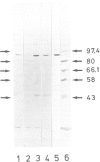Abstract
Monoclonal antibodies raised against the rat liver glucocorticoid receptor were used to investigate receptors of wild-type and glucocorticoid-resistant variants of mouse lymphoma cells. Two of the variant types contained receptors of 'nuclear transfer deficient' (nt-) and 'increased nuclear transfer' (nti) phenotypes, respectively, while the third was of the 'receptorless' (r-) phenotype with negligible hormone binding activity. Three monoclonal antibodies of the IgM class and one of the IgG class reacted with both wild-type and nt- receptors but not with the steroid binding form of nti receptors. Some of the antibodies bound the wild-type and nt- receptors more efficiently after activation at 20 degrees C. By use of an immuno-competition assay we were able to detect cross-reacting material in considerable amounts in extracts of nti and r- cell variants. This material was further characterized by gel filtration and immunoblotting. The immunoreactive material of wild-type, nti and r- cells gave a major band of mol. wt. 94 000 upon SDS-gel electrophoresis while the steroid-binding polypeptides of wild-type and nti receptors have mol. wts. of 94 000 and 40 000, respectively. The data show that in S49.1 mouse lymphoma cells the products of two receptor alleles can be distinguished.
Full text
PDF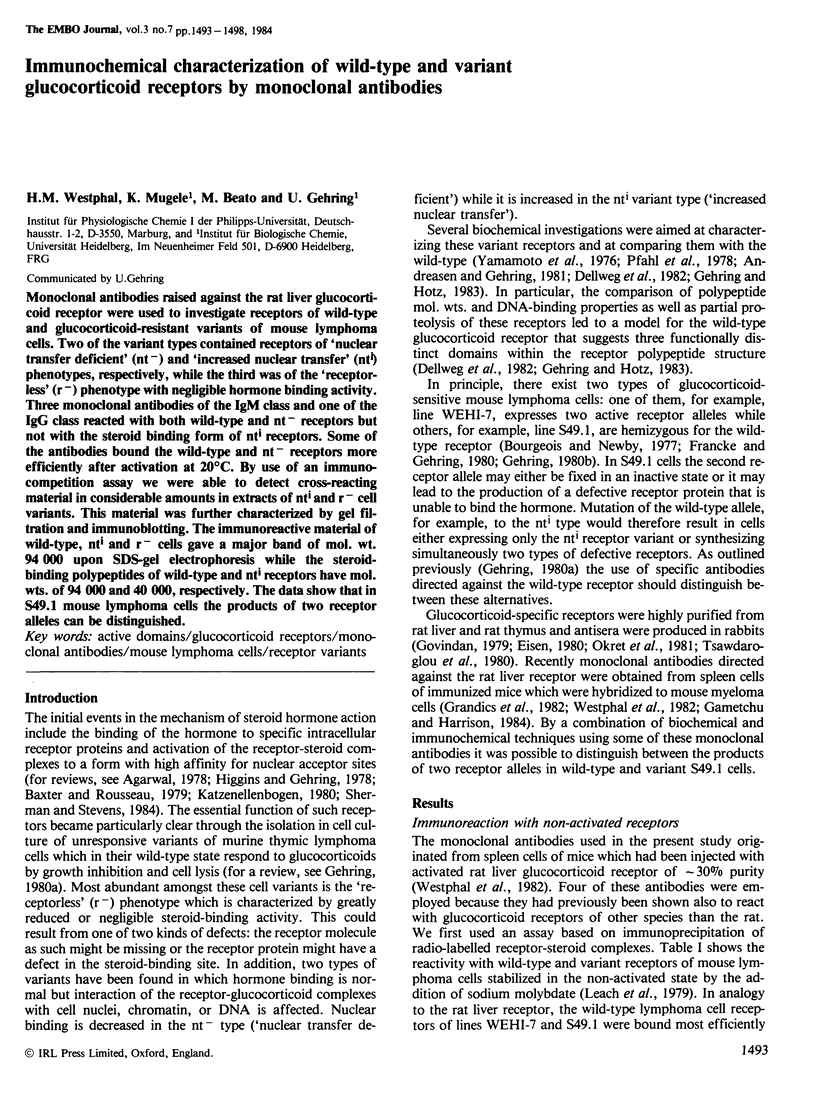
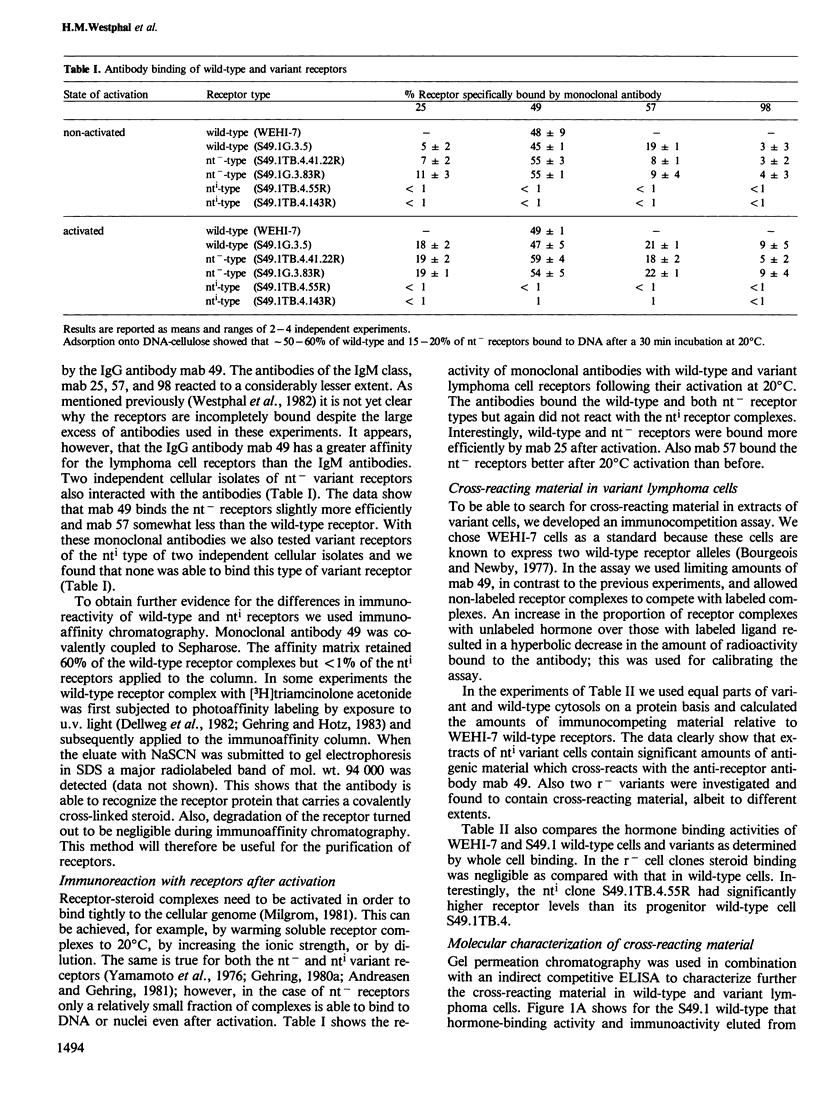
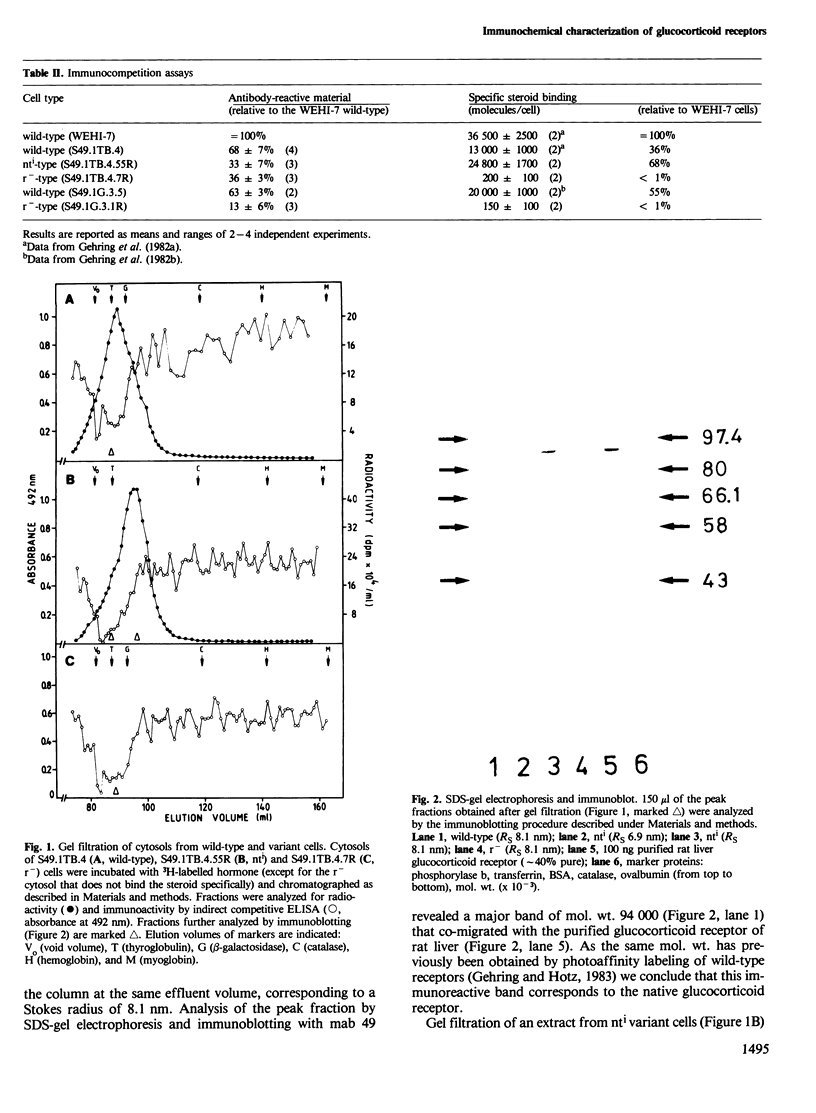
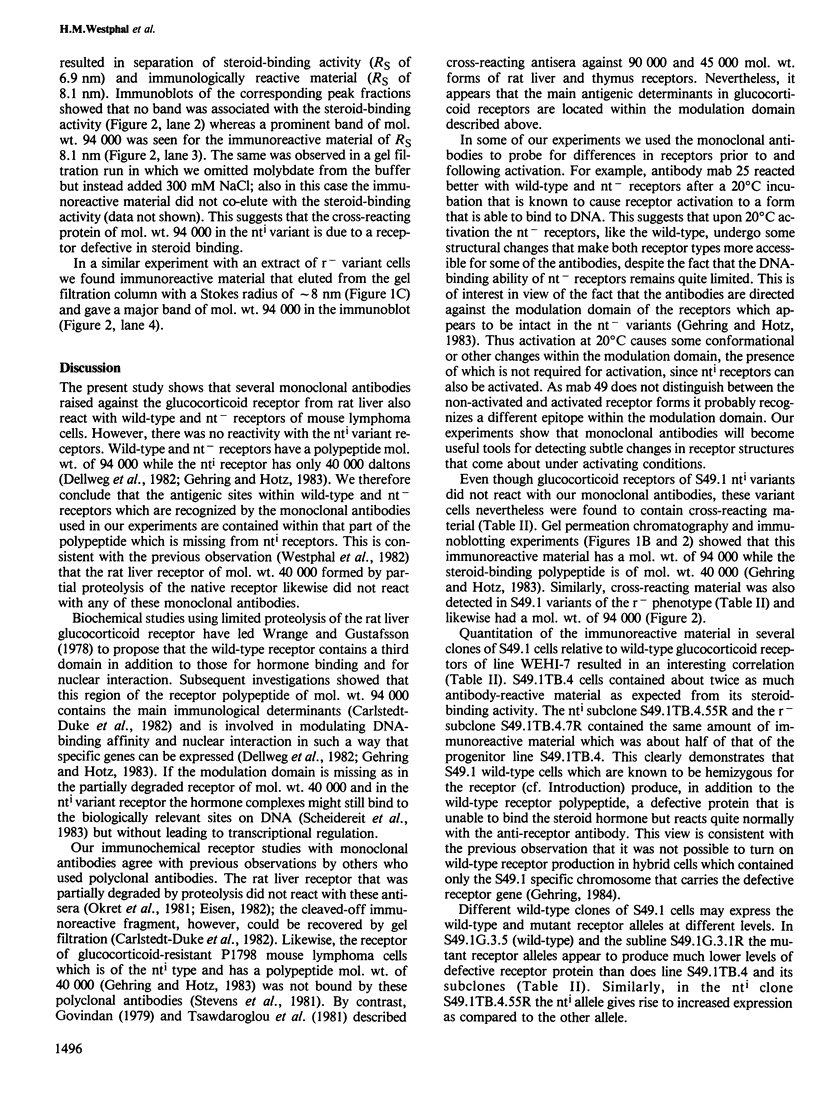
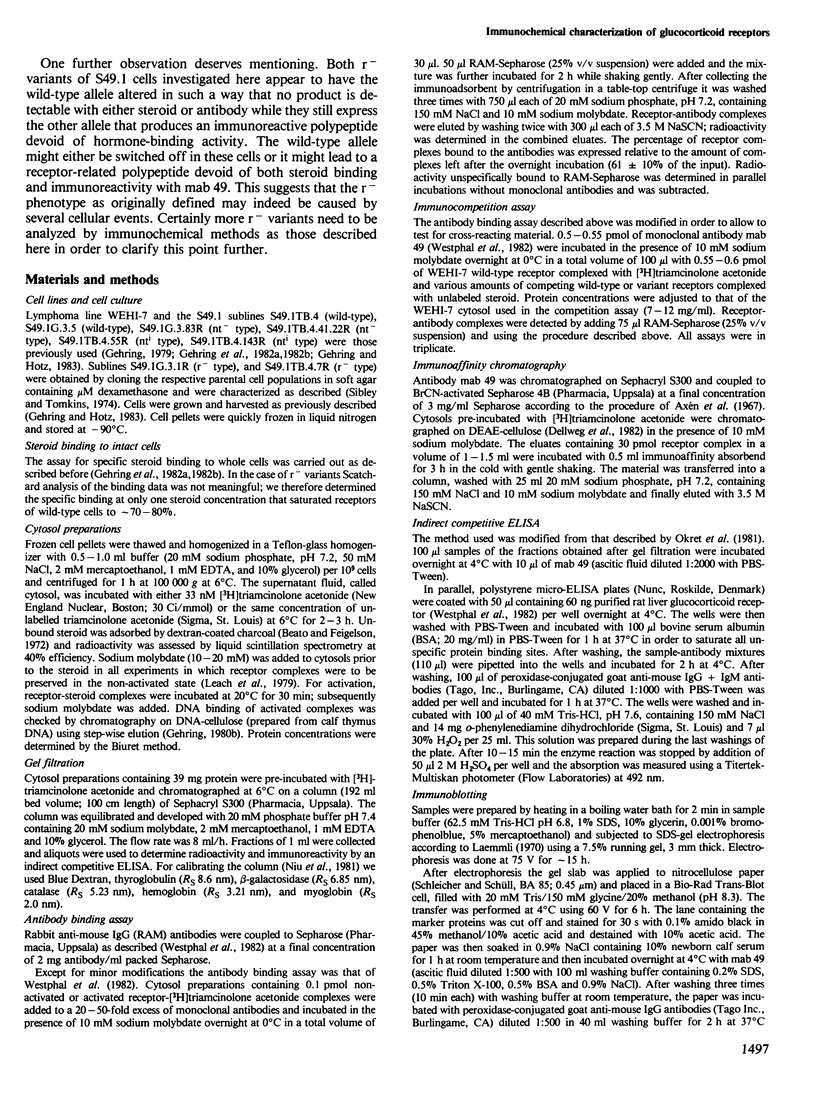
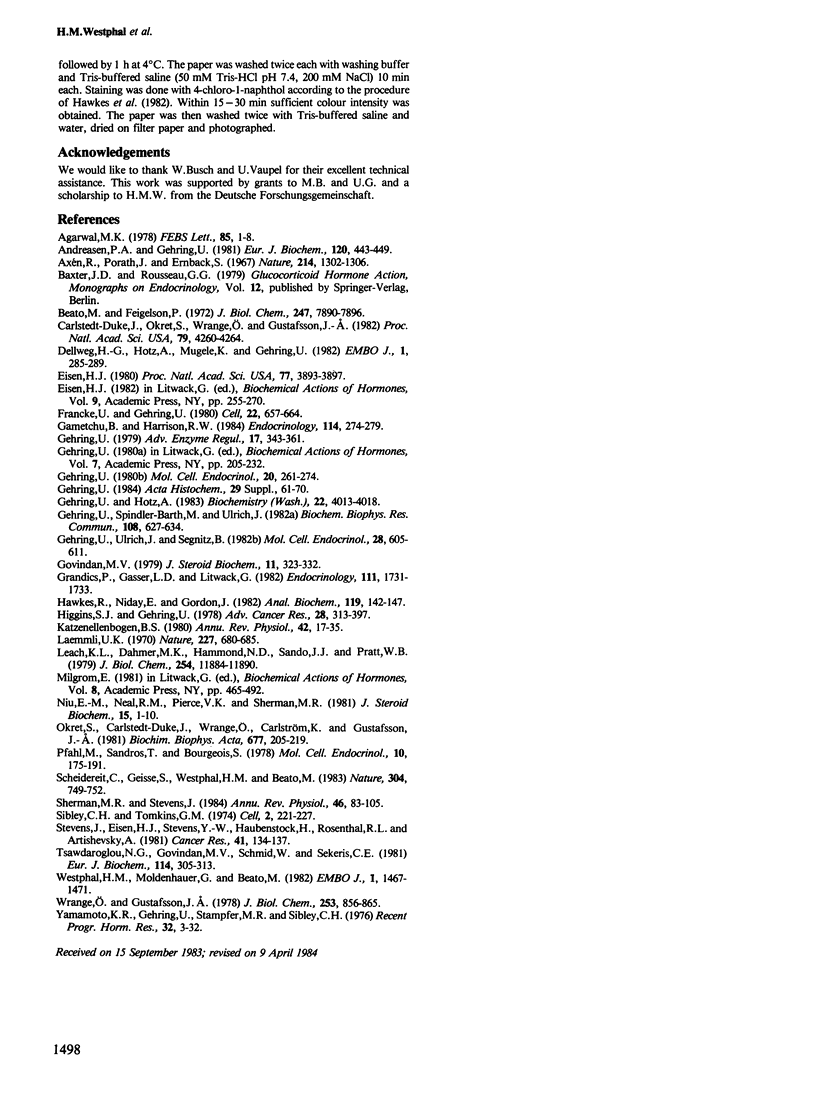
Images in this article
Selected References
These references are in PubMed. This may not be the complete list of references from this article.
- Agarwal M. K. Physical characterisation of cytoplasmic gluco- and mineralo-steroid receptors. FEBS Lett. 1978 Jan 1;85(1):1–8. doi: 10.1016/0014-5793(78)81237-x. [DOI] [PubMed] [Google Scholar]
- Andreasen P. A., Gehring U. Activation and partial proteolysis of variant glucocorticoid receptors, studied by two-phase partitioning. Eur J Biochem. 1981 Dec;120(3):443–449. doi: 10.1111/j.1432-1033.1981.tb05722.x. [DOI] [PubMed] [Google Scholar]
- Axén R., Porath J., Ernback S. Chemical coupling of peptides and proteins to polysaccharides by means of cyanogen halides. Nature. 1967 Jun 24;214(5095):1302–1304. doi: 10.1038/2141302a0. [DOI] [PubMed] [Google Scholar]
- Beato M., Feigelson P. Glucocorticoid-binding proteins of rat liver cytosol. I. Separation and identification of the binding proteins. J Biol Chem. 1972 Dec 25;247(24):7890–7896. [PubMed] [Google Scholar]
- Carlstedt-Duke J., Okret S., Wrange O., Gustafsson J. A. Immunochemical analysis of the glucocorticoid receptor: identification of a third domain separate from the steroid-binding and DNA-binding domains. Proc Natl Acad Sci U S A. 1982 Jul;79(14):4260–4264. doi: 10.1073/pnas.79.14.4260. [DOI] [PMC free article] [PubMed] [Google Scholar]
- Dellweg H. G., Hotz A., Mugele K., Gehring U. Active domains in wild-type and mutant glucocorticoid receptors. EMBO J. 1982;1(3):285–289. doi: 10.1002/j.1460-2075.1982.tb01161.x. [DOI] [PMC free article] [PubMed] [Google Scholar]
- Eisen H. J. An antiserum to the rat liver glucocorticoid receptor. Proc Natl Acad Sci U S A. 1980 Jul;77(7):3893–3897. doi: 10.1073/pnas.77.7.3893. [DOI] [PMC free article] [PubMed] [Google Scholar]
- Francke U., Gehring U. Chromosome assignment of a murine glucocorticoid receptor gene (Grl-1) using intraspecies somatic cell hybrids. Cell. 1980 Dec;22(3):657–664. doi: 10.1016/0092-8674(80)90541-3. [DOI] [PubMed] [Google Scholar]
- Gametchu B., Harrison R. W. Characterization of a monoclonal antibody to the rat liver glucocorticoid receptor. Endocrinology. 1984 Jan;114(1):274–279. doi: 10.1210/endo-114-1-274. [DOI] [PubMed] [Google Scholar]
- Gehring U. Genetic analysis of glucocorticoid action in neoplastic lymphoid cells. Adv Enzyme Regul. 1978;17:343–361. doi: 10.1016/0065-2571(79)90021-9. [DOI] [PubMed] [Google Scholar]
- Gehring U. Genetic studies on steroid hormone receptors. Acta Histochem Suppl. 1984;29:61–70. [PubMed] [Google Scholar]
- Gehring U., Hotz A. Photoaffinity labeling and partial proteolysis of wild-type and variant glucocorticoid receptors. Biochemistry. 1983 Aug 16;22(17):4013–4018. doi: 10.1021/bi00286a004. [DOI] [PubMed] [Google Scholar]
- Gehring U. Specific receptors control steroid sensitivity in lymphoma cell hybrids. Mol Cell Endocrinol. 1980 Dec;20(3):261–274. doi: 10.1016/0303-7207(80)90042-8. [DOI] [PubMed] [Google Scholar]
- Gehring U., Spindler-Barth M., Ulrich J. Different states of glucocorticoid receptors in intact cells and cytosol preparations. Biochem Biophys Res Commun. 1982 Sep 30;108(2):627–634. doi: 10.1016/0006-291x(82)90875-0. [DOI] [PubMed] [Google Scholar]
- Gehring U., Ulrich J., Segnitz B. Lymphoma cell variants of decreased glucocorticoid sensitivity. Mol Cell Endocrinol. 1982 Nov-Dec;28(3):605–611. doi: 10.1016/0303-7207(82)90149-6. [DOI] [PubMed] [Google Scholar]
- Govindan M. V. Purification of glucocorticoid receptors from rat liver cytosol. Preparation of antibodies against the major receptor proteins and application of immunological techniques to study activation and translocation. J Steroid Biochem. 1979 Jul;11(1A):323–332. doi: 10.1016/0022-4731(79)90315-7. [DOI] [PubMed] [Google Scholar]
- Grandics P., Gasser D. L., Litwack G. Monoclonal antibodies to the glucocorticoid receptor. Endocrinology. 1982 Nov;111(5):1731–1733. doi: 10.1210/endo-111-5-1731. [DOI] [PubMed] [Google Scholar]
- Hawkes R., Niday E., Gordon J. A dot-immunobinding assay for monoclonal and other antibodies. Anal Biochem. 1982 Jan 1;119(1):142–147. doi: 10.1016/0003-2697(82)90677-7. [DOI] [PubMed] [Google Scholar]
- Higgins S. J., Gehring U. Molecular mechanisms of steroid hormone action. Adv Cancer Res. 1978;28:313–397. doi: 10.1016/s0065-230x(08)60650-8. [DOI] [PubMed] [Google Scholar]
- Katzenellenbogen B. S. Dynamics of steroid hormone receptor action. Annu Rev Physiol. 1980;42:17–35. doi: 10.1146/annurev.ph.42.030180.000313. [DOI] [PubMed] [Google Scholar]
- Laemmli U. K. Cleavage of structural proteins during the assembly of the head of bacteriophage T4. Nature. 1970 Aug 15;227(5259):680–685. doi: 10.1038/227680a0. [DOI] [PubMed] [Google Scholar]
- Leach K. L., Dahmer M. K., Hammond N. D., Sando J. J., Pratt W. B. Molybdate inhibition of glucocorticoid receptor inactivation and transformation. J Biol Chem. 1979 Dec 10;254(23):11884–11890. [PubMed] [Google Scholar]
- Niu E. M., Neal R. M., Pierce V. K., Sherman M. R. Structural similarity of molybdate-stabilized steroid receptors in human breast tumors, uteri and leukocytes. J Steroid Biochem. 1981 Dec;15:1–10. doi: 10.1016/0022-4731(81)90251-x. [DOI] [PubMed] [Google Scholar]
- Okret S., Carlstedt-Duke J., Wrange O., Carlström K., Gustafsson J. A. Characterization of an antiserum against the glucocorticoid receptor. Biochim Biophys Acta. 1981 Oct 12;677(2):205–219. doi: 10.1016/0304-4165(81)90087-8. [DOI] [PubMed] [Google Scholar]
- Pfahl M., Sandros T., Bourgeois S. Interaction of glucocorticoid receptors from lymphoid cell lines with their nuclear acceptor sites. Mol Cell Endocrinol. 1978 Apr;10(2):175–191. doi: 10.1016/0303-7207(78)90124-7. [DOI] [PubMed] [Google Scholar]
- Scheidereit C., Geisse S., Westphal H. M., Beato M. The glucocorticoid receptor binds to defined nucleotide sequences near the promoter of mouse mammary tumour virus. Nature. 1983 Aug 25;304(5928):749–752. doi: 10.1038/304749a0. [DOI] [PubMed] [Google Scholar]
- Sherman M. R., Stevens J. Structure of mammalian steroid receptors: evolving concepts and methodological developments. Annu Rev Physiol. 1984;46:83–105. doi: 10.1146/annurev.ph.46.030184.000503. [DOI] [PubMed] [Google Scholar]
- Sibley C. H., Tomkins G. M. Mechanisms of steroid resistance. Cell. 1974 Aug;2(4):221–227. doi: 10.1016/0092-8674(74)90014-2. [DOI] [PubMed] [Google Scholar]
- Stevens J., Eisen H. J., Stevens Y. W., Haubenstock H., Rosenthal R. L., Artishevsky A. Immunochemical differences between glucocorticoid receptors from corticoid-sensitive and -resistant malignant lymphocytes. Cancer Res. 1981 Jan;41(1):134–137. [PubMed] [Google Scholar]
- Tsawdaroglou N. G., Govindan M. V., Schmid W., Sekeris C. E. Dexamethasone-binding proteins in cytosol and nucleus of rat thymocytes. Purification of three receptor proteins. Eur J Biochem. 1981;114(2):305–313. doi: 10.1111/j.1432-1033.1981.tb05150.x. [DOI] [PubMed] [Google Scholar]
- Westphal H. M., Moldenhauer G., Beato M. Monoclonal antibodies to the rat liver glucocorticoid receptor. EMBO J. 1982;1(11):1467–1471. doi: 10.1002/j.1460-2075.1982.tb01339.x. [DOI] [PMC free article] [PubMed] [Google Scholar]
- Wrange O., Gustafsson J. A. Separation of the hormone- and DNA-binding sites of the hepatic glucocorticoid receptor by means of proteolysis. J Biol Chem. 1978 Feb 10;253(3):856–865. [PubMed] [Google Scholar]
- Yamamoto K. R., Gehring U., Stampfer M. R., Sibley C. H. Genetic approaches to steroid hormone action. Recent Prog Horm Res. 1976;32:3–32. doi: 10.1016/b978-0-12-571132-6.50008-7. [DOI] [PubMed] [Google Scholar]



